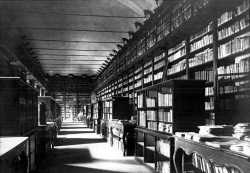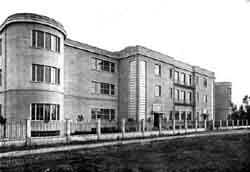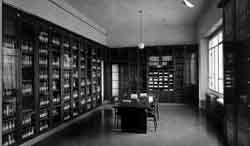|
|
•The Library
Creation
The library was created during the general university reform movement which took place in Hapsburg Europe in the eighteenth century. From the organisational point of view, one of the major reforms was the creation of valuable support structures for the students. It was during this period in Pavia that the botanical gardens, the anatomy theatre, the natural history museum, the laboratory for physics and chemistry experiments and also the library were all founded. the organisational point of view, one of the major reforms was the creation of valuable support structures for the students. It was during this period in Pavia that the botanical gardens, the anatomy theatre, the natural history museum, the laboratory for physics and chemistry experiments and also the library were all founded.
At the time, the only library that Pavia had was in the Ghisleri College, to which books began to flow. After being transferred to another site in the College itself, the library was opened to the public in 1772. Meanwhile the building of the university was underway and preparations were made to house the library in the great hall (subsequently called “Teresian”) designed by the architect Piermarini.
The hall was equipped with impressive wooden bookshelves /bookcases , which are still preserved today, and, towards the end of 1778, the library material was transferred there from the Ghisleri University Library and set up as the “Imperial Ticino Library”.
Contents and significance
Apart from the original nucleus of 12,000 volumes transferred from the Ghisleri library, duplicates of volumes in the Brera Library, Milan, and the Vienna library were gradually added to enlarge this patrimony. So too were part of the Pertusati library, the scientific section of the Haller and Firmian collection, as well as remnants from suppressed religious orders. Vienna library were gradually added to enlarge this patrimony. So too were part of the Pertusati library, the scientific section of the Haller and Firmian collection, as well as remnants from suppressed religious orders.
It is evident that Austrian cultural policy intended to make the Pavia library different from the Brera one by giving it a specially scientific character. This is clear from the way the books were split up between Milan and Pavia, when the private collections of Haller, Firmian and Pertusati were bought. This scientific connotation was clearly underlined by the purchase of science magazines and records of proceedings in the most important Italian and European academies. This collection of “Academic Acts” is repeatedly cited as being “unique in Europe” and “the library’s greatest endowment”. It is bibliographically rare because it is so complete, consisting as it does of whole series of “acts” from almost all the European scientific academies, as well as those from Asia and America founded on the European pattern towards the end of the eighteenth century.
This scientific significance of the library was to dominate until almost the end of the nineteenth century, when acquisitions started to become more evenly balanced between the various disciplines.
Subsequently, there was a reduction in the cultural emphasis in early twentieth-century Italy. A new idealism dominated, with its dangerous depreciation of scientific thought as such. The library changed its look to become “humanistic in character” and its acquisitions were primarily in the realm of “speculative” science. The contemporary move away from clinics and the scientific institutes in towns/centres of habitation???????????towards the founding and development of faculty libraries also contributed to this change.
• Physics Library

The “A. Volta” Physics institute was finished in 1935. From that year dates the independent development of this special library, the only one able to provide bibliographical support at once and at any moment.. The new collection has developed over nearly two centuries from a significant historical base – mainly nineteenth-century but with some rare editions from the seventeenth and eighteenth centuries – and continued growing, thanks to bequests, gifts and purchases, into the present working Faculty library. the independent development of this special library, the only one able to provide bibliographical support at once and at any moment.. The new collection has developed over nearly two centuries from a significant historical base – mainly nineteenth-century but with some rare editions from the seventeenth and eighteenth centuries – and continued growing, thanks to bequests, gifts and purchases, into the present working Faculty library.
Having been transferred into an appropriate room, the above-mentioned nucleus forms the “historical basis” of the interdepartmental library. This library is made up from three Physics Institutes (General, Theoretical and Nuclear), which have today become two Departments : the “A.Volta” Physics Department, and the Nuclear and Theoretical Physics one.
|